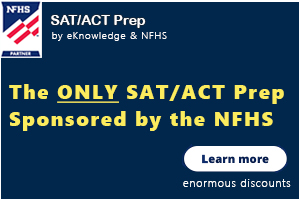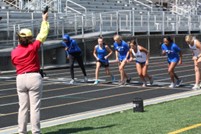- Home
- The Role of the Starter in a High School Meet
The Role of the Starter in a High School Meet
By Julie Cochran, NFHS Director of Sports and Middle Schools on April 04, 2025 Track & Field/Cross Country article PrintA fair and efficient start can make all the difference in a track and field race. The role of the starter is crucial in ensuring that every athlete is given an equal opportunity to compete while maintaining the integrity of the event. Whether overseeing sprints or distance races, starters must be consistent, clear, and prepared to handle false starts with confidence.
The starter’s primary responsibility is to ensure that all athletes have a fair and equal start. Giving clear and consistent commands that all competitors can hear and respond to at the start of the race. As well as identifying and addressing false starts to maintain fairness in competition.
Clear and Consistent Commands – If you have the luxury of amplification, you should use it. Do not shout, scream or harshly give the start commands. The "On Your Marks" command should be given in a clear confident voice, ensuring athletes move into their correct starting position without hesitation.
Do not rush to the "Set" command. Allow the sprinters to establish a stable position as they all have their personal preparation rituals. After the last competitor appears ready wait 2-3 seconds before giving the “Set” command. The command should be clear, direct and in a neutral tone.
The starter should fire the starting device at a consistent and predictable interval after the “Set” command to prevent athletes from anticipating the start. A well-timed start ensures fairness—if the signal is given too quickly, athletes may not be fully prepared, resulting in an unfair advantage or disadvantage. Conversely, delaying too long can cause unnecessary tension and disrupt focus. According to NFHS rules, the interval between the “Set” command and the start signal should be approximately two seconds to maintain consistency and fairness in competition.
In distance races, the starter should ensure that all athletes are still and prepared before firing the starting device. With the command "On your marks" all competitors will step to the starting line without delay. When all competitors are steady and motionless without their hand(s) touching the ground, the starter shall fire the starting device.
The most important command a starter can utilize is “Stand Up”. This command should be used freely any time an unfair situation is sensed or to prevent a false start. The 2025-26 NFHS Officials Manual has a detailed list for reasons to halt the start process. Assistant starters observing the start may also use this command. Once this command has been issued, unless it is given because of a false start before the signal, all competitors can come out of the start position without penalty, and the process can begin again.
Starters should position themselves where they have a clear line of sight to all athletes. In a staggered start it is best to have an assistant (recall) starter, but in regular season high school meets this is not always the case. The 2025-26 NFHS Officials Manual has diagrams for positioning suggestions on pages 19-20.
At large invitationals and state championship meets there is usually a team of starters. Frequently these teams rotate the starter and assistant starter roles to help develop more officials.
Assistant starters should be active in preventative officiating and freely use the “Stand up” command to correct situations and report to the starter. Assistant starters should keep their finger on the outside of the trigger guard to avoid unnecessary recalls. Quietly correct athletes whose fingers are on the start lines and if they refuse direction the “Stand up” command should be used, and the athlete warned. If more than one assistant recalls a race, each report should be independently given to the starter and the starter will make their decision.
False Starts
Extraneous motion before the device is fired does not necessarily require a false start be charged. If the starter thinks the movement creates a situation of unfairness to any of the competitors, the starter may cancel the start with the command “Stand Up," or if the device has been fired, recall the race as an unsteady or unfair start and redo the start procedure.
NFHS Starting Violations:
- Failure to comply with the starter's commands.
- Having any part of the body in contact with the starting line or running surface beyond the line, when the starting device is fired.
- If a runner leaves their mark with a hand or foot after the “set” command but before the starting device is fired.
- If a runner leaves their mark with a forward motion without the starting device being fired.
- Failure to place starting blocks within the respective competitor's lane.
- Repeated use of disconcerting acts.
With preventative officiating many of these violations can be avoided by a good starting crew, but false starts can still happen and the penalty in high school meets is disqualification.
Overall, an effective starting crew should remain impartial, work closely with clerks and fellow officials, use clear and confident commands, stay composed under pressure, and adapt to varying environmental conditions such as noise, wind, or inclement weather. A well-trained and consistent starter plays a vital role in ensuring fairness, upholding professionalism, and maintaining the integrity of competition. By executing proper starting techniques and managing false starts effectively, officials create an environment where every athlete has a fair and equal opportunity to compete at their best. A smooth, well-executed start sets the tone for the race and the meet — so let’s make every start count!
Julie Cochran, NFHS Director of Sports and Middle Schools
Most Recent Articles
- Track & Field/Cross Country article The Role of the Starter in a High School Meet
- nfhs news NFHS, NCAA, SFIA put on 2025 Team Sports Conference
- nfhs news Coaching Mental Wellness Course Now Offered on NFHS Learning Center
- nfhs news Final Four Participants Hope to Repeat State Championship Experiences
- nfhs news Former NFHS Assistant Director Susan True Passes Away







